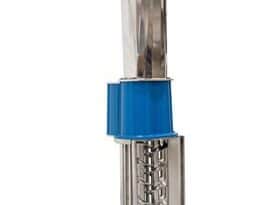how to perform pump corrosion checks
Pump corrosion is a significant issue that can compromise the integrity and functionality of pumping systems. It occurs when chemical reactions, often involving environmental elements such as water, oxygen, and various chemicals, degrade the pump materials over time. Understanding the mechanisms behind pump corrosion is essential for implementing effective maintenance practices and ensuring the longevity of pump operations.
Several factors contribute to the onset and progression of pump corrosion:
- Chemical Composition: The presence of corrosive substances like acids, salts, and other aggressive chemicals in the fluid being pumped can accelerate material degradation.
- Environmental Exposure: Pumps exposed to harsh environmental conditions, such as high humidity or temperature fluctuations, are more susceptible to corrosion.
- Material Selection: Inadequate material selection for pump components can lead to increased vulnerability to corrosive agents.
- Operational Stress: High pressure and temperature conditions can exacerbate corrosive processes, especially if the pump operates continuously without adequate maintenance.
The impact of pump corrosion extends beyond reduced efficiency; it can lead to unexpected downtime, increased operational costs, and safety hazards. Common manifestations of pump corrosion include pitting, scaling, and uniform corrosion, each affecting different parts of the pump system such as the impeller, casing, and seals.
To effectively monitor and address pump corrosion, regular corrosion checks should be integrated into the routine inspection schedule. This proactive approach not only helps in early detection of corrosion-related issues but also in planning appropriate mitigation strategies to uphold the reliability and performance of the pumping equipment.
Additionally, understanding the types of corrosion can aid in selecting suitable preventive measures:
| Type of Corrosion | Description | Common Causes |
|---|---|---|
| Uniform Corrosion | Evenly distributed material loss over surfaces. | General exposure to corrosive environments. |
| Pitting Corrosion | Localized pits or holes forming on the surface. | Presence of specific corrosive agents like chlorides. |
| Galvanic Corrosion | Corrosion resulting from electrical potential differences between dissimilar metals. | Contact between different metals in the presence of an electrolyte. |
| Crevice Corrosion | Occurs in shielded areas such as joints or under deposits. | Restricted access to the corrosive environment within gaps. |
By comprehensively understanding pump corrosion, maintenance teams can better tailor their strategies to mitigate risks, enhance pump reliability, and extend the service life of pumping systems.
inspecting pump components
Inspecting the various components of a pump is crucial in identifying and addressing pump corrosion early. A systematic approach ensures that all critical areas are thoroughly examined, minimizing the risk of unexpected failures and extending the pump’s operational life.
Key Components to Inspect:
- Impeller: Examine for signs of pitting, erosion, or material loss. Look for discoloration or deformation that may indicate corrosive wear.
- Casing: Check the internal and external surfaces for uniform corrosion, cracks, or scaling. Pay special attention to areas around joints and seams where corrosion is more likely to initiate.
- Shaft: Inspect for surface rust, discoloration, or any signs of weakening. Ensure that the shaft alignment remains intact and free from corrosion-induced deviations.
- Seals and Bearings: Assess the condition of seals for any deterioration or leakage that might suggest corrosion. Bearings should be checked for corrosion-related wear or damage.
- Connections and Fittings: Look for galvanic corrosion at connection points, especially where dissimilar metals are used. Tighten any loose fittings and replace corroded components as necessary.
Inspection Techniques and Tools:
Utilizing the right tools and techniques enhances the effectiveness of pump component inspections. The following methods are recommended:
| Technique | Description | Tools Required |
|---|---|---|
| Visual Inspection | Conduct a thorough visual examination of all accessible areas to identify obvious signs of corrosion and damage. | Flashlight, magnifying glass, inspection mirrors |
| Ultrasonic Thickness Measurement | Measure the thickness of pump components to detect material loss due to corrosion. | Ultrasonic thickness gauge |
| Borescope Inspection | Use a borescope to inspect internal areas that are not easily accessible, such as inside the casing and impeller chambers. | Borescope camera |
| Magnetic Particle Testing | Identify surface and near-surface cracks or defects that may be caused by corrosion. | Magnetic particle kit |
| Eddy Current Testing | Detect surface cracks and measure conductivity changes in materials affected by corrosion. | Eddy current probe |
Steps for Effective Inspection:
- Preparation: Ensure the pump is safely isolated and de-energized. Follow lockout/tagout (LOTO) procedures to prevent accidental operation during inspection.
- Accessing Components: Remove any necessary covers or guards to gain access to the pump’s internal components. Handle all parts with care to avoid introducing new damage.
- Conducting Visual and Non-Destructive Examinations: Perform visual inspections complemented by non-destructive testing methods to identify both surface and hidden corrosion.
- Recording Findings: Document all observations meticulously, noting the extent and location of any corrosion or damage discovered during the inspection.
- Evaluating Severity: Assess the impact of the identified corrosion on pump performance and determine the urgency of maintenance actions required.
- Reporting: Compile a comprehensive report detailing the inspection results, including photographs and measurements, to inform maintenance planning and decision-making.
Regular and thorough inspections of pump components not only help in detecting pump corrosion early but also play a vital role in planning targeted maintenance activities. By leveraging appropriate tools and adhering to structured inspection protocols, maintenance teams can effectively safeguard the integrity and performance of pumping systems.
testing corrosion levels
Testing corrosion levels is a critical aspect of maintaining the integrity and performance of pumping systems. Accurate assessment of corrosion allows for timely interventions, preventing minor issues from escalating into major failures. The following outlines the primary methods and tools used to evaluate corrosion in pumps, as well as the steps involved in conducting these tests effectively.
Corrosion Testing Methods:
| Method | Description | Advantages | Limitations |
|---|---|---|---|
| Ultrasonic Thickness Measurement | Uses high-frequency sound waves to measure the thickness of pump components, indicating material loss due to corrosion. | Non-destructive, provides precise measurements, quick to perform. | Requires access to both sides of the component, skilled operator needed. |
| Linear Polarization Resistance (LPR) | Electrochemical technique to assess the rate of corrosion by measuring the polarization resistance of a metal surface. | Provides real-time corrosion rate data, suitable for continuous monitoring. | Requires specialized equipment and expertise, sensitive to environmental conditions. |
| Visual Inspection with Corrosion Probes | Employs probes inserted into the pump system to visually identify areas affected by corrosion. | Simple and cost-effective, allows for direct observation of corrosion. | Limited to accessible areas, may not detect subsurface corrosion. |
| Electrochemical Impedance Spectroscopy (EIS) | Measures the impedance of the pump material to evaluate corrosion processes and protective layer integrity. | Detailed information on corrosion mechanisms, suitable for complex assessments. | High complexity, requires sophisticated equipment and interpretation. |
| Mass Loss Coupons | Small metal samples placed within the pump environment to measure corrosion over time by calculating weight loss. | Simple implementation, provides cumulative corrosion data. | Time-consuming, only provides indirect measurement of corrosion rates. |
Essential Tools for Corrosion Testing:
- Ultrasonic Thickness Gauge: Essential for non-destructive thickness measurements of pump components.
- Electrochemical Analyzers: Used for techniques like LPR and EIS to measure corrosion rates and impedance.
- Corrosion Probes: Devices that facilitate visual inspections and localized corrosion assessments.
- Mass Loss Coupons: Small metal specimens used to monitor corrosion over extended periods.
- Digital Microscopes: Provide high-resolution images for detailed examination of corroded surfaces.
Steps to Test Corrosion Levels:
- Preparation:
- Ensure the pump system is safely isolated and depressurized.
- Clean the areas to be tested to remove any debris or deposits that may interfere with measurements.
- Calibrate all testing equipment according to the manufacturer’s instructions to ensure accurate results.
- Select Appropriate Testing Method:
- Choose a method based on the specific requirements of the pump system, such as accessibility, required precision, and available resources.
- Consider combining multiple methods for a comprehensive assessment.
- Conduct the Test:
- Follow standardized procedures for the selected corrosion testing method to ensure consistency and reliability.
- Collect data systematically, noting the location and extent of corrosion observed.
- Analyze Results:
- Compare measured values against acceptable thresholds defined by industry standards or manufacturer guidelines.
- Identify trends or patterns that indicate the progression of corrosion over time.
- Interpret Findings:
- Determine the severity of the corrosion and its potential impact on pump performance and safety.
- Prioritize areas requiring immediate maintenance or further investigation.
- Report and Document:
- Compile a comprehensive report detailing the testing methodology, findings, and recommendations for maintenance actions.
- Include visual aids such as charts, graphs, and photographs to support the analysis.
Interpreting Corrosion Data:
Effective interpretation of corrosion testing results is essential for informed decision-making in pump maintenance. The data collected should be evaluated against baseline measurements and industry benchmarks to assess the current state of the pump system.
- Baseline Comparison: Establishing a baseline from initial measurements helps in tracking the progression of corrosion over time.
- Thresholds and Limits: Refer to industry standards, such as those from the American Society of Mechanical Engineers (ASME), to determine acceptable corrosion levels.
- Risk Assessment: Evaluate the potential risks associated with the identified corrosion, including the likelihood of pump failure and safety hazards.
- Maintenance Planning: Use the analysis to prioritize maintenance tasks, allocate resources efficiently, and implement preventive measures to mitigate future corrosion.
Regularly testing corrosion levels as part of routine checks ensures that pump systems remain reliable and operational. By employing a combination of advanced testing methods and thorough data analysis, maintenance teams can effectively manage pump corrosion, thereby extending the service life of the equipment and reducing the likelihood of unexpected downtime.
preventive maintenance strategies
 Implementing effective strategies is essential to minimize pump corrosion and ensure the longevity of pumping systems. Proactive measures not only prevent the onset of corrosion but also enhance the overall reliability and efficiency of pump operations. The following approaches can be integrated into a comprehensive maintenance program to safeguard against corrosion-related issues:
Implementing effective strategies is essential to minimize pump corrosion and ensure the longevity of pumping systems. Proactive measures not only prevent the onset of corrosion but also enhance the overall reliability and efficiency of pump operations. The following approaches can be integrated into a comprehensive maintenance program to safeguard against corrosion-related issues:
Material Selection:
Choosing the appropriate materials for pump components is fundamental in resisting corrosive environments. Materials should be selected based on the specific conditions they will encounter, such as the presence of aggressive chemicals, temperature ranges, and mechanical stresses.
- Stainless Steels: Offer excellent resistance to a wide range of corrosive agents, making them suitable for environments with high chemical exposure.
- Alloys: Specialized alloys, such as duplex stainless steels, provide enhanced strength and corrosion resistance.
- Non-Metallic Materials: Components made from plastics or composites can be used in applications where metal corrosion is a significant concern.
Protective Coatings:
Applying protective coatings to pump components creates a barrier between the material and corrosive agents, significantly reducing the risk of corrosion.
| Coating Type | Description | Applications |
|---|---|---|
| Epoxy Coatings | Provide a durable, chemical-resistant layer that prevents moisture and corrosive substances from reaching the metal surface. | Internal and external surfaces of pump casings and piping. |
| Polyurethane Coatings | Offer excellent abrasion resistance and flexibility, suitable for dynamic environments. | Impellers and moving parts subjected to wear and tear. |
| Galvanization | Involves coating steel or iron with a layer of zinc to protect against oxidation and corrosion. | External pump structures exposed to atmospheric conditions. |
Cathodic Protection:
This technique involves making the pump components the cathode of an electrochemical cell, thereby preventing oxidation and corrosion. It is particularly effective in environments where pumps are submerged or exposed to highly corrosive media.
- Sacrificial Anodes: Attach metals like zinc or magnesium that preferentially corrode, protecting the primary pump materials.
- Impressed Current Systems: Use an external power source to provide a continuous protective current to pump components.
Environmental Control:
Regulating the operating environment can significantly reduce the factors that contribute to pump corrosion. Controlling temperature, humidity, and exposure to corrosive agents helps maintain the integrity of pump systems.
- Temperature Regulation: Maintain optimal operating temperatures to prevent thermal degradation of materials.
- Humidity Control: Use dehumidifiers or protective enclosures in areas with high moisture levels.
- Aeration Management: Limit the exposure of pump materials to oxygen by using inert atmospheres where feasible.
Regular Maintenance and Monitoring:
Consistent maintenance routines and ongoing monitoring are crucial in identifying early signs of corrosion and addressing them before they escalate.
| Activity | Description | Frequency |
|---|---|---|
| Scheduled Inspections | Perform routine checks of pump components for signs of wear and corrosion. | Monthly or as recommended by manufacturer. |
| Corrosion Inhibitors | Add chemicals to the pumped fluid that reduce the rate of corrosion. | As needed based on fluid chemistry. |
| Lubrication Maintenance | Ensure proper lubrication of moving parts to minimize friction and prevent corrosion. | Regular intervals, typically weekly or bi-weekly. |
Implementing Best Practices:
Adhering to industry best practices enhances the effectiveness of preventive measures and ensures a systematic approach to corrosion management.
- Training and Education: Equip maintenance personnel with the knowledge and skills required to identify and address corrosion issues effectively.
- Standard Operating Procedures (SOPs): Develop and enforce SOPs for maintenance tasks, inspections, and emergency responses related to corrosion.
- Continuous Improvement: Regularly review and update maintenance strategies based on the latest industry advancements and feedback from inspections.
By integrating these preventive measures into the maintenance regimen, organizations can significantly reduce the incidence of pump corrosion, ensure sustained pump performance, and extend the operational lifespan of their pumping systems. Proactive maintenance not only mitigates the risks associated with corrosion but also contributes to overall operational efficiency and cost-effectiveness.
documenting and reporting findings
Accurate and thorough documentation is essential in the process of pump corrosion checks, as it ensures that findings are systematically recorded, easily accessible, and actionable. Effective reporting not only facilitates informed decision-making but also enhances communication among maintenance teams, management, and other stakeholders. The following guidelines outline the key elements and best practices for documenting and reporting pump corrosion findings:
Essential Components of Documentation:
- Inspection Details: Record the date, time, and location of the inspection, along with the names of the personnel involved. Include information about the specific pump being examined, such as its model, serial number, and operating conditions.
- Observations: Provide a detailed description of the corrosion observed, including the type, extent, and location. Use standardized terminology to ensure clarity and consistency.
- Measurements: Include quantitative data from corrosion tests, such as thickness measurements, corrosion rates, and any relevant numerical indicators. Present this data in an organized manner to facilitate analysis.
- Photographic Evidence: Incorporate high-resolution images of corroded areas to visually support the written observations. Annotate photographs to highlight specific issues and areas of concern.
- Analysis and Interpretation: Offer an assessment of the corrosion findings, discussing their potential impact on pump performance and integrity. Include comparisons to baseline data or industry standards to contextualize the severity of the corrosion.
- Recommendations: Provide actionable suggestions for addressing the identified corrosion, such as repair procedures, material replacements, or adjustments to maintenance schedules. Prioritize recommendations based on the urgency and impact of the findings.
Structured Reporting Formats:
Utilizing standardized reporting formats enhances the consistency and comprehensibility of corrosion check documentation. Common formats include:
| Format | Description | Benefits |
|---|---|---|
| Inspection Reports | Comprehensive documents that compile all aspects of the inspection, including methodologies, findings, analyses, and recommendations. | Provides a complete overview of the inspection, useful for historical records and long-term tracking. |
| Corrosion Logs | Detailed logs that record ongoing corrosion observations and measurements over time. | Facilitates trend analysis and helps in identifying patterns or recurring issues. |
| Summary Reports | Concise documents that highlight key findings and critical issues from the corrosion checks. | Useful for quick reviews by management and stakeholders who require high-level information. |
| Digital Dashboards | Interactive platforms that display real-time corrosion data, trends, and alerts. | Enhances accessibility of information and supports proactive maintenance actions. |
Best Practices for Effective Documentation:
Adhering to best practices ensures that documentation is reliable, clear, and useful for all parties involved. Key practices include:
- Standardization: Develop and implement standardized templates and terminology to maintain consistency across all reports and records.
- Detail Orientation: Provide comprehensive details without overcomplicating the report. Balance thoroughness with clarity to ensure the information is easily digestible.
- Timeliness: Complete documentation promptly after inspections to capture accurate and relevant information while it is still fresh.
- Accuracy: Ensure all data and observations are recorded precisely. Double-check measurements and verify information to minimize errors.
- Accessibility: Store documents in centralized, secure locations where authorized personnel can easily access and retrieve them as needed.
- Confidentiality: Protect sensitive information by restricting access to authorized individuals and using secure storage solutions.
Tools and Technologies for Documentation:
Leveraging modern tools and technologies can streamline the documentation and reporting process, enhancing efficiency and accuracy. Common tools include:
- Maintenance Management Software: Utilize computerized maintenance management systems (CMMS) to organize, track, and manage corrosion check records and reports.
- Digital Inspection Forms: Implement electronic forms and mobile applications that allow inspectors to record findings directly in the field, reducing the risk of data entry errors.
- Photographic Software: Use software that enables easy annotation, categorization, and storage of inspection photographs.
- Data Visualization Tools: Employ tools like Microsoft Excel, Tableau, or specialized dashboards to create visual representations of corrosion data, aiding in analysis and reporting.
- Cloud Storage Solutions: Store documentation in cloud-based platforms to ensure data is backed up, secure, and accessible from multiple locations.
Effective Reporting Strategies:
To maximize the impact of documentation, adopt strategies that enhance the clarity and usefulness of reports:
- Clarity and Brevity: Present information in a clear and concise manner. Avoid jargon and overly complex language to ensure reports are understandable by all stakeholders.
- Visual Aids: Incorporate charts, graphs, and images to illustrate data and highlight key findings. Visual aids can make complex information more accessible and easier to interpret.
- Actionable Insights: Focus on providing recommendations and next steps based on the findings. Ensure that reports not only identify issues but also offer solutions.
- Regular Updates: Maintain a consistent reporting schedule to keep all parties informed about the current state of pump corrosion and the effectiveness of maintenance strategies.
- Feedback Integration: Encourage feedback from report recipients to improve future documentation practices and address any gaps or concerns.
Ensuring Compliance and Accountability:
Proper documentation and reporting also contribute to regulatory compliance and accountability within the organization:
- Regulatory Standards: Adhere to industry standards and regulations regarding documentation practices to ensure compliance and avoid potential penalties.
- Audit Trails: Maintain comprehensive records that can be reviewed during audits, demonstrating adherence to maintenance protocols and corrosion management practices.
- Accountability: Assign responsibility for documentation tasks to specific personnel, ensuring that records are maintained consistently and accurately.
By meticulously documenting and reporting pump corrosion check findings, organizations can establish a robust maintenance framework that supports proactive corrosion management. Comprehensive records enable the identification of trends, informed decision-making, and the implementation of effective maintenance strategies, ultimately enhancing the reliability and longevity of pumping systems.




